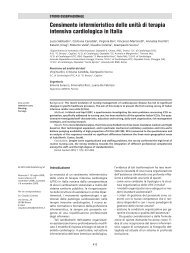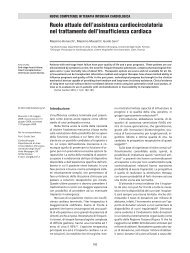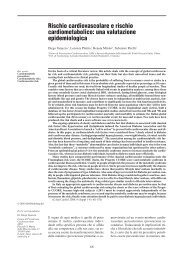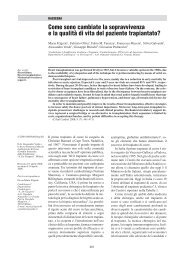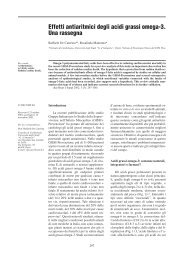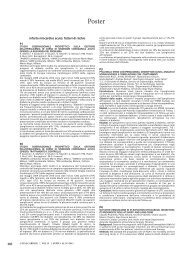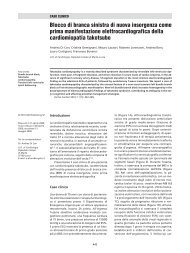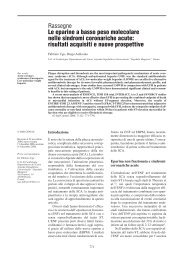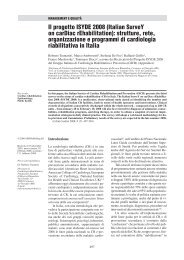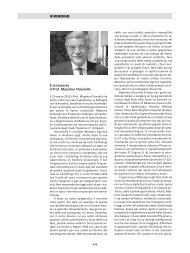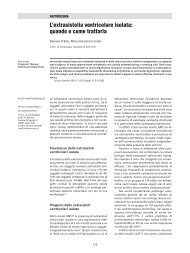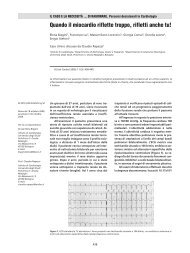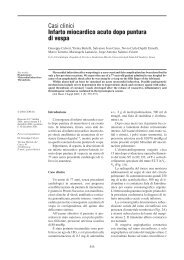COMUNICAZIONI - Giornale Italiano di Cardiologia
COMUNICAZIONI - Giornale Italiano di Cardiologia
COMUNICAZIONI - Giornale Italiano di Cardiologia
You also want an ePaper? Increase the reach of your titles
YUMPU automatically turns print PDFs into web optimized ePapers that Google loves.
Comunicazioni<br />
Risultati acuti.<br />
TEE ICE p<br />
Successo procedurale 94.3 % 98.6% ns<br />
Mortalità 0% 0% ns<br />
Trombosi acuta device 1.4% 0% ns<br />
Shunt residuo 1.4% 0% ns<br />
Aritmie intraprocedurali 0% 0% ns<br />
Risultati clinici a lungo termine.<br />
Tempi (minuti)<br />
TEE ICE p TEE ICE p<br />
N. pazienti 70 70 Tempo <strong>di</strong> scopia 5.1 2.3 0.05<br />
Morte 0% 0% ns Tempo <strong>di</strong> procedura 49.9 39.9 0.05<br />
Complicanze 0% 0% ns<br />
neurologiche<br />
Complicanze 0% 0% ns<br />
car<strong>di</strong>ovascolari<br />
Conclusioni. Nel trattamento percutaneo <strong>di</strong> occlusione <strong>di</strong> DIA, evidenze cliniche<br />
e strumentali hanno mostrato elevate e sovrapponibili percentuali <strong>di</strong> successo<br />
acuto e lungo termine, sia con l’impiego <strong>di</strong> TEE sia <strong>di</strong> ICE. In pazienti non<br />
selezionati, la meto<strong>di</strong>ca ICE si è <strong>di</strong>mostrata in grado <strong>di</strong> ridurre significativamente<br />
i tempi <strong>di</strong> scopia e <strong>di</strong> procedura, evitando inoltre la sedazione profonda del<br />
paziente, necessaria con l’impiego della TEE.<br />
C39<br />
EJECTION FRACTION-VELOCITY RATIO FOR THE ASSESSMENT OF<br />
AORTIC BIOPROSTHETIC VALVES IN PATIENTS WITH SYSTOLIC<br />
DYSFUNCTION<br />
A. Rossi*, P. Cattaneo*, M. Baravelli*, P. Marchetti**, A. Picozzi*, D. Imperiale*,<br />
M.C. Rossi*, P. Dario*, G. Cannizzaro**, C. Anzà*<br />
*Department of Car<strong>di</strong>ology and Car<strong>di</strong>ac Rehabilitation, MultiMe<strong>di</strong>ca Hol<strong>di</strong>ngs<br />
Santa Maria, Castellanza, Varese, Italy,**Department of Car<strong>di</strong>ology and Car<strong>di</strong>ac<br />
Surgery, University of Insubria, Ospedale <strong>di</strong> Circolo e Fondazione Macchi,<br />
Varese, Italy<br />
Aims. The continuity equation represents the gold standard for the evaluation of<br />
aortic valve area in patients with aortic stenosis, but it is subject to error, time<br />
consuming, and can be technically deman<strong>di</strong>ng. Recently, a new<br />
echocar<strong>di</strong>ographic non-flow corrected index has been introduced and<br />
demonstrated an excellent accuracy in quantifying the effective orifice area in<br />
native aortic valves and bioprostheses. This new index, the ejection fractionvelocity<br />
ratio, is obtained by <strong>di</strong>vi<strong>di</strong>ng the percent left ventricular ejection fraction<br />
at the maximum aortic gra<strong>di</strong>ent (EFVR=EF/4V 2 ). The aim of our study was to<br />
assess the utility of this echocar<strong>di</strong>ographic index to quantify the effective orifice<br />
area in patients with aortic bioprosthesis and left ventricular dysfunction.<br />
Methods. We stu<strong>di</strong>ed 70 patients (25 women and 45 men, mean age of 71.4±9<br />
years) with aortic bioprosthesis and left ventricular dysfunction (EF ≤49%), and<br />
we evaluated the effective orifice area by both continuity equation and ejection<br />
fraction-velocity ratio.<br />
Results. We found a significant linear correlation between the continuity equation<br />
and the ejection fraction-velocity ratio (r=0.80; p



